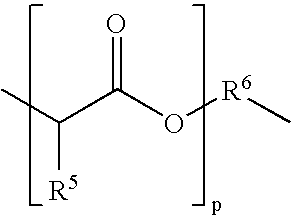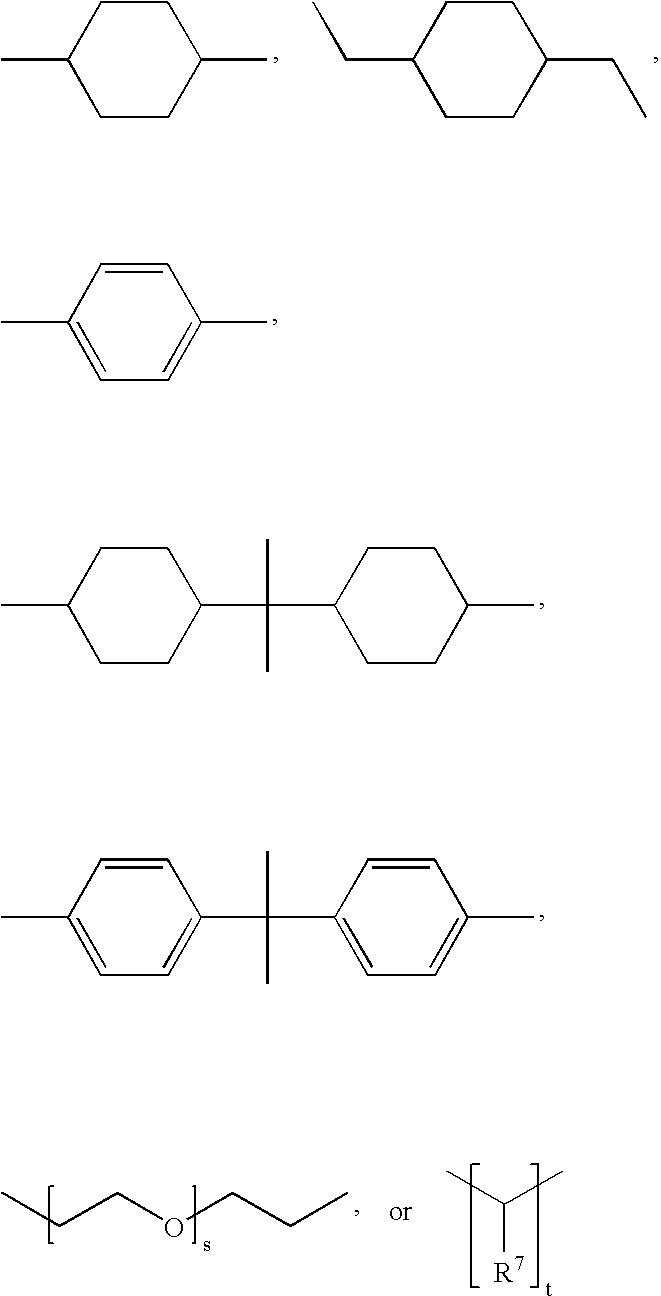Bioerodible poly(ortho esters) from dioxane-based di(ketene acetals), and block copolymers containing them
a dioxane-based di and dioxane acetal technology, applied in the field of poly(ortho esters), can solve the problems of limiting the amount of water that can penetrate the polymer, requiring elevated temperature and reduced pressure, and requiring relatively long reaction tim
- Summary
- Abstract
- Description
- Claims
- Application Information
AI Technical Summary
Benefits of technology
Problems solved by technology
Method used
Image
Examples
example 1
Preparation of Poly(Ortho Esters) of Formula I
[0161] In a 100 mL round bottom flask was placed 1.143 g (3.5 mmol) di[(5-ethyl-2-ethylidene-[1,3]dioxan-5-yl)methyl]ether (DEEDME), 0.743 g (4.95 mmol) triethylene glycol (TEG), 0.013 g (0.05 mmol) triethylene glycol monoglycolide (TEG-GL) and 5 mL tetrahydrofuran (THF). The reaction was initiated by the addition of a small amount of a salicylic acid solution in THF. After about 30 minutes, 0.1 mL triethylamine was added to neutralize the acidic catalyst and the solvent removed by evaporation to give a poly(ortho ester) of formula I where R is—CH2OCH2—, Ra is ethyl, Rb is ethyl, and A is a mixture of 1 mol % R1 (where p is 1, R5 is hydrogen, and R6 is —CH2CH2OCH2CH2OCH2CH2—) and 99% R3 (where R3 is —CH2CH2OCH2CH2OCH2CH2—). [Need to fill in viscosity and MWt].
[0162] Following an identical procedure, 0.98 g (3.0 mmole) DEEDME, 0.743 g (4.95 mmol) TEG, and 0.013 g (0.05 mmol) TEG-GL were used to give a poly(ortho ester) of formula I wher...
example 2
Comparison of Poly(Ortho Esters) Based on DEEDME and DETOSU
[0166] Following the procedure of Example 1, 1.632 g (5.0 mmol) DEEDME and 0.721 g (5.0 mmol) trans-cyclohexanedimethanol (CDM) were used to give a poly(ortho ester). The molecular weight was 11,400 Da and the glass transition temperature was 31.9° C. Using DETOSU instead of DEEDME gave a similar poly(ortho ester) having a glass transition temperature of 115° C. This illustrates the dramatic lowering in glass transition temperature of poly(ortho esters) achievable by using the flexible di(ketene acetals) of formula III.
example 3
Preparation of a Diblock Copolymer of Formula X
[0167] Under anhydrous conditions, 2 g (1 mmol) PEG 2000 mono-methyl ether (MPEG 2000) and 3.26 g (10 mmol) DEEDME are weighed into a 50 mL flask and dissolved in 5 mL THF. A solution of p-toluenesulfonic acid in THF (5 μL, 20 mg / mL) is added to the MPEG 2000 / DEEDME solution to initiate the reaction between the MPEG 2000 and the DEEDME, and the reaction mixture is stirred for about 20 minutes. CDM (1.32 g, 9.15 mmol) and 0.021 g (0.1 mmol) TEG-mGL in 5 mL THF are added to the flask, followed by another 5 mL p-toluenesulfonic acid solution. The reaction mixture is stirred for about 30 minutes, and then added dropwise to about 100 mL hexane with vigorous stirring, precipitating the diblock copolymer product, which is separated by filtration and dried in a vacuum oven.
PUM
| Property | Measurement | Unit |
|---|---|---|
| diameter | aaaaa | aaaaa |
| pH | aaaaa | aaaaa |
| mole percentage | aaaaa | aaaaa |
Abstract
Description
Claims
Application Information
 Login to View More
Login to View More - R&D
- Intellectual Property
- Life Sciences
- Materials
- Tech Scout
- Unparalleled Data Quality
- Higher Quality Content
- 60% Fewer Hallucinations
Browse by: Latest US Patents, China's latest patents, Technical Efficacy Thesaurus, Application Domain, Technology Topic, Popular Technical Reports.
© 2025 PatSnap. All rights reserved.Legal|Privacy policy|Modern Slavery Act Transparency Statement|Sitemap|About US| Contact US: help@patsnap.com



